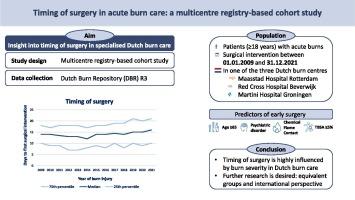Timing of surgery in acute burn care: A multicentre registry-based cohort study
Q3 Medicine
Burns open : an international open access journal for burn injuries
Pub Date : 2025-01-01
DOI:10.1016/j.burnso.2024.100391
引用次数: 0
Abstract
Early excision and grafting are standard care for severe burns, though implementation varies globally. In the Netherlands, surgery for moderate and severe burns tends to be relatively late. This study analysed the timing of surgery in Dutch burn care by examining patient, injury and treatment characteristics, and clinical outcomes. A multicentre registry-based cohort study was conducted using data from the Dutch Burn Repository R3 (2009–2021), including adult patients who underwent surgery at a Dutch burn centre. The primary outcome was surgical timing, with patients classified into early (≤7 days) and late surgery (>7 days) groups. Multivariable logistic regression identified predictors of early surgery, while trends in timing were assessed with quantile regression. The median time to surgery was 14 days (Q1–Q3: 9.0–19.0), with 670 of 3291 patients receiving early surgery (20 %). Surgical timing increased slightly over the 13-year period. Predictors of early surgery included older age, larger total body surface area burned, psychiatric medical history, and flame, flash, and contact burns compared to scald burns. This study underscores the nuanced Dutch policy regarding surgery and the influence of burn severity on surgical timing. Further research is needed, focusing on patient-centred outcomes and international perspectives.

急性烧伤护理的手术时机:一项多中心登记队列研究
早期切除和移植是严重烧伤的标准治疗方法,尽管在全球范围内实施不同。在荷兰,中度和重度烧伤的手术往往相对较晚。本研究通过检查患者、损伤和治疗特征以及临床结果,分析了荷兰烧伤护理的手术时机。使用荷兰烧伤库R3(2009-2021)的数据进行了一项多中心登记队列研究,包括在荷兰烧伤中心接受手术的成年患者。主要终点为手术时机,将患者分为早期(≤7 天)和晚期(>;7 天)组。多变量逻辑回归确定了早期手术的预测因素,而分位数回归评估了手术时间的趋势。中位手术时间为14 天(Q1-Q3: 9.0-19.0), 3291例患者中670例接受早期手术(20% %)。手术时机在13年期间略有增加。早期手术的预测因素包括年龄较大、烧伤总面积较大、精神病史以及与烫伤烧伤相比的火焰、闪光和接触烧伤。这项研究强调了荷兰关于手术和烧伤严重程度对手术时机的影响的微妙政策。需要进一步的研究,重点放在以患者为中心的结果和国际视野上。
本文章由计算机程序翻译,如有差异,请以英文原文为准。
求助全文
约1分钟内获得全文
求助全文
来源期刊
CiteScore
1.20
自引率
0.00%
发文量
0
审稿时长
15 weeks

 求助内容:
求助内容: 应助结果提醒方式:
应助结果提醒方式:


